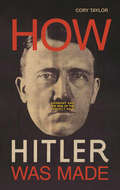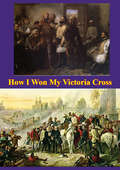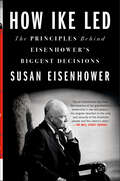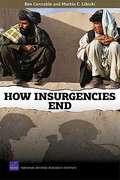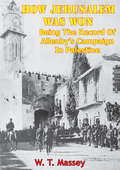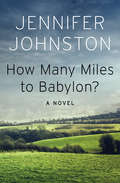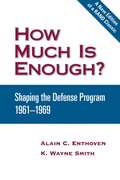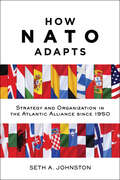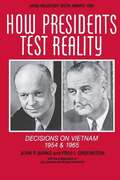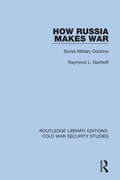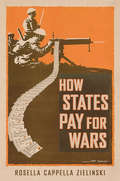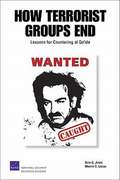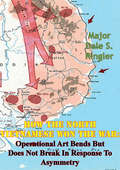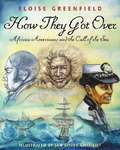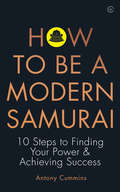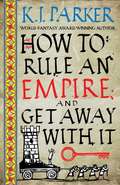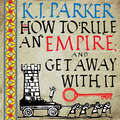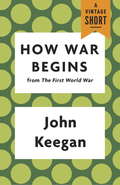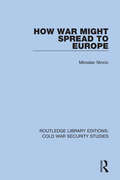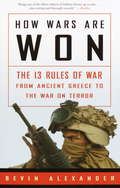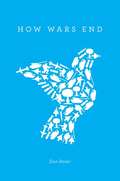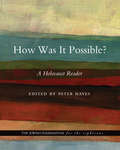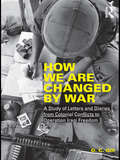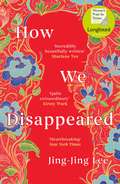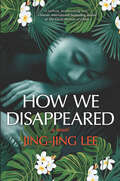- Table View
- List View
How Hitler Was Made: Germany and the Rise of the Perfect Nazi
by Cory TaylorFocusing on German society immediately following the First World War, this vivid historical narrative explains how fake news and political uproar influenced Hitler and put him on the path toward dictatorial power.How did an obscure agitator on the political fringes of early-20th-century Germany rise to become the supreme leader of the "Third Reich"? Unlike many other books that track Adolf Hitler's career after 1933, this book focuses on his formative period--immediately following World War I (1918-1924). The author, a veteran producer of historical documentaries, brings to life this era of political unrest and violent conflict, when forces on both the left and right were engaged in a desperate power struggle. Among the competing groups was a highly sophisticated network of ethnic chauvinists that discovered Hitler and groomed him into the leader he became. The book also underscores the importance of a post-war socialist revolution in Bavaria, led by earnest reformers, some of whom were Jewish. Right wing extremists skewed this brief experiment in democracy followed by Soviet-style communism as evidence of a Jewish-Bolshevik plot. Along with the pernicious "stab-in-the-back" myth, which misdirected blame for Germany's defeat onto civilian politicians, public opinion was primed for Hitler to use his political cunning and oratorical powers to effectively blame Jews and Communists for all of Germany's problems.Based on archival research in Germany, England, and the US, this striking narrative reveals how the manipulation of facts and the use of propaganda helped an obscure, embittered malcontent to gain political legitimacy, which led to dictatorial power over a nation.
How I Won My Victoria Cross [Illustrated Edition]
by Thomas Henry Kavanagh VC[Illustrated with over one hundred maps, photos and portraits, of the battles, individuals and places involved in the Indian Mutiny]The siege of Lucknow remains, even after one hundred and fifty years have passed, the most iconic struggle of the Indian Mutiny of 1857; the British, their families and loyal sepoys were surrounded in the rambling buildings of the Residence. Other British forces were on their way to relieve the garrison, which was surrounded by 10,000 furious rebel troops and internally wracked by hunger, filth, cholera, dysentery and small pox. The question remained, would the relieving forces be able to reach the beleaguered men women and children in Lucknow in time?A hero emerged from the unlikeliest source; among the non-combatant civil service men holed up in the residence was an Irishman named Thomas Henry Kavanagh inspired by the chance to win undying glory. "I resolved to die in the struggle," he writes, "rather than survive it with no better fame than I took into it." He engaged in every dirty and dangerous job during the siege; leading a group of fellow civil service volunteers as a mobile reserve around the most embattled parts of the fortifications, manning field mortars, counter-tunnelling against a bomb attempt by the rebels.However, his lasting fame rests on his epic quest to escape the garrison disguised as a sepoy, and guide the relieving forces into the city of Lucknow and past the defences of the mutineers. This journey was as difficult as one can imagine and forms the subject of this famous book; the perilous journey would be recognized as one of the bravest feats of the entire conflict Kavanagh was awarded the coveted Victoria Cross for outstanding bravery, one of only five civilians to ever do so.
How Ike Led: The Principles Behind Eisenhower's Biggest Decisions
by Susan Eisenhower“Lays bare the essence of [President Eisenhower’s] leadership in war and peace—his singular devotion to the unity and security of the American people.” —The Wall Street JournalFew leaders have made decisions as momentous—and varied—as Dwight D. Eisenhower. From D-Day to Little Rock, from the Korean War to Cold War crises, from the Red Scare to the Missile Gap controversies, Ike was able to give our country eight years of peace and prosperity by relying on a core set of principles. These were informed by his heritage and upbringing, as well as his strong character and personal discipline—but he also avoided making himself the center of things. He was a man of judgment, and a steadying force. He sought national unity by pursuing a course he called the “Middle Way” that tried to make winners on both sides of any issue.Ike was a strategic, not an operational leader, who relied on a rigorous pursuit of the facts for decision-making. His talent for envisioning a whole, especially in the context of the long game, and his ability to see causes and various consequences, explains his success as Allied Commander and as President. After making a decision, he made himself accountable for it, recognizing that personal responsibility is the bedrock of sound principles.Written by his granddaughter, a policy analyst and national security expert, How Ike Led reveals the personality, beliefs, and habits that allowed Eisenhower to lead America through a transformational time.“As good a picture of Ike as we have ever had.” —David Nichols, author of Eisenhower 1956“Highly personal anecdotes supplement [the author’s] research. Armchair historians will treasure this book.” —BooklistIncludes photographs
How Insurgencies End
by Martin C. Libicki Ben ConnableRAND studied 89 modern insurgency cases to test conventional understanding about how insurgencies end. Findings relevant to policymakers and analysts include that modern insurgencies last about ten years; withdrawal of state support cripples insurgencies; civil defense forces are useful for both sides; pseudodemocracies fare poorly against insurgents; and governments win more often in the long run.
How Jerusalem Was Won - Being the Record of Allenby’s Campaign in Palestine [Illustrated Edition]: Being the Record of Allenby’s Campaign in Palestine
by William Thomas MasseyIncludes the World War One In The Desert Illustration Pack- 115 photos/illustrations and 19 maps spanning the Desert campaigns 1914-1918"Written by the foremost accredited London newspaper journalist in the Middle East during the Great War, William Massey covered the war in the Middle East as it was fought against the Ottoman Turkish Empire, its German ally and the tribes of the region who supported them. He was aware of the hardships suffered by the British and Colonial troops serving in the difficult climate and later became a champion of those who fought there. He writes of the complete conflict from the battles in the western desert with the Senussi to Aleppo and beyond to the borders of Turkey."-Print Ed.
How Many Miles to Babylon?: A Novel (Penguin Essentials Ser. #63)
by Jennifer JohnstonFrom a Whitbread Award–winning author: A WWI novel of loyalty and friendship &“graced with the immanent lyrical talent of the Irish writers at their best&” (Kirkus Reviews, starred review). Born to an aristocratic family on an estate outside of Dublin, Alexander Moore feels the constraints of his position most acutely in his friendship with Jerry Crowe, a Catholic laborer in town. Jerry is one of the few bright spots in Alec&’s otherwise troubled life. The boys bond over their love of swimming and horses, despite the admonitions of Alec&’s cold and overbearing mother, who scolds her son for venturing outside of his class. When the Great War begins, he seizes the opportunity to escape his overbearing mother and taciturn father, and enlists in the British army. Jerry, too, enlists—not out of loyalty to Britain, but to prepare himself for the Republican cause. Stationed in Flanders, the young men are reunited and find that, while encamped in the trenches, their commonalities are what help them survive. Now a lieutenant and an officer, Alec and Jerry again find their friendship under assault, this time from the rigid Major Glendinning, whose unyielding adherence to rank leads the two men toward a harrowing impasse that will change their lives forever.
How Much Is Enough?
by K. Wayne Smith Alain C. EnthovenOriginally published in 1971, and now published with a new foreword, this is a book of enduring value and lasting relevance. The authors detail the application, history, and controversies surrounding the Planning, Programming, and Budgeting System (PPBS), used to evaluate military needs and to choose among alternatives for meeting those needs.
How NATO Adapts: Strategy and Organization in the Atlantic Alliance since 1950 (The Johns Hopkins University Studies in Historical and Political Science #132)
by Seth A. JohnstonDespite momentous change, NATO remains a crucial safeguard of security and peace.Today’s North Atlantic Treaty Organization, with nearly thirty members and a global reach, differs strikingly from the alliance of twelve created in 1949 to "keep the Americans in, the Russians out, and the Germans down." These differences are not simply the result of the Cold War’s end, 9/11, or recent twenty-first-century developments but represent a more general pattern of adaptability first seen in the incorporation of Germany as a full member of the alliance in the early 1950s. Unlike other enduring post–World War II institutions that continue to reflect the international politics of their founding era, NATO stands out for the boldness and frequency of its transformations over the past seventy years.In this compelling book, Seth A. Johnston presents readers with a detailed examination of how NATO adapts. Nearly every aspect of NATO—including its missions, functional scope, size, and membership—is profoundly different than at the organization’s founding. Using a theoretical framework of "critical junctures" to explain changes in NATO’s organization and strategy throughout its history, Johnston argues that the alliance’s own bureaucratic actors played important and often overlooked roles in these adaptations. Touching on renewed confrontation between Russia and the West, which has reignited the debate about NATO’s relevance, as well as a quarter century of post–Cold War rapprochement and more than a decade of expeditionary effort in Afghanistan, How NATO Adapts explores how crises from Ukraine to Syria have again made NATO’s capacity for adaptation a defining aspect of European and international security. Students, scholars, and policy practitioners will find this a useful resource for understanding NATO, transatlantic relations, and security in Europe and North America, as well as theories about change in international institutions.
How Presidents Test Reality: Decisions on Vietnam, 1954 And 1965
by Fred I. Greenstein John P. BurkeThe authors are concerned with establishing whether policy alternatives were systematically and rigorously addressed when Eisenhower made his decision not to intervene in Vietnam in 1954 and Johnson made the opposite decision in 1965 (the intrinsic quality of the decisions themselves is not their focus). Sources include recently declassified records and interviews with participants.
How Russia Makes War: Soviet Military Doctrine (Routledge Library Editions: Cold War Security Studies #26)
by Raymond L. GarthoffThis book, first published in 1954, is a key analysis of the guiding policies, basic assumptions, fundamental principles and methods of the Red Army, in many respects the most powerful force in the Cold War. This analysis examines the strategy and tactics, weapons systems, training, discipline and political doctrine of the Red Army, as well as focusing on the political control of the USSR and its satellite states.
How States Pay for Wars
by Rosella Capella ZielinskiArmies fight battles, states fight wars. To focus solely on armies is to neglect the broader story of victory and defeat. Military power stems from an economic base, and without wealth, soldiers cannot be paid, weapons cannot be procured, and food cannot be bought. War finance is among the most consequential decisions any state makes: how a state finances a war affects not only its success on the battlefield but also its economic stability and its leadership tenure. In How States Pay for Wars, Rosella Cappella Zielinski clarifies several critical dynamics lying at the nexus of financial and military policy.Cappella Zielinski has built a custom database on war funding over the past two centuries, and she combines those data with qualitative analyses of Truman's financing of the Korean War, Johnson’s financing of the Vietnam War, British financing of World War II and the Crimean War, and Russian and Japanese financing of the Russo-Japanese War. She argues that leaders who attempt to maximize their power at home, and state power abroad, are in a constant balancing act as they try to win wars while remaining in office. As a result of political risks, they prefer war finance policies that meet the needs of the war effort within the constraints of the capacity of the state.
How Terrorist Groups End: Lessons for Countering Al Qa'ida
by Seth G. Jones Martin C. LibickiAll terrorist groups eventually end. But how do they end? The evidence since 1968 indicates that most groups have ended because (1) they joined the political process (43 percent) or (2) local police and intelligence agencies arrested or killed key members (40 percent). Military force has rarely been the primary reason for the end of terrorist groups, and few groups within this time frame have achieved victory. This has significant implications for dealing with al Qa'ida and suggests fundamentally rethinking post-9/11 U.S. counterterrorism strategy: Policymakers need to understand where to prioritize their efforts with limited resources and attention. The authors report that religious terrorist groups take longer to eliminate than other groups and rarely achieve their objectives. The largest groups achieve their goals more often and last longer than the smallest ones do. Finally, groups from upper-income countries are more likely to be left-wing or nationalist and less likely to have religion as their motivation. The authors conclude that policing and intelligence, rather than military force, should form the backbone of U.S. efforts against al Qa'ida. And U.S. policymakers should end the use of the phrase 'war on terrorism' since there is no battlefield solution to defeating al Qa'ida.
How The North Vietnamese Won The War: Operational Art Bends But Does Not Break In Response To Asymmetry
by Major Dale S. RinglerThis monograph analyzes the effectiveness of operational campaign design against an asymmetrical threat during the 1968 Tet Offensive. The focus is on conceptual elements of campaign design that are derived from theory, which incorporate the particulars of military history to the general truth of warfare. Effective campaign execution is dependent, in part, on effective campaign design that set of theoretical and doctrinal precepts that define the concerns of the operational planner. The monograph identifies lessons learned from this period that are applicable to current U.S. Joint and Army doctrine as well as lessons for planners and executors of U.S. military action under the American system of civilian control of the military.First, the monograph demonstrated the complex nature of asymmetric warfare. Finding and creating vulnerabilities and attacking those vulnerabilities with inherent strengths is the key to asymmetric warfare. Secondly, the monograph discussed the elements of campaign design that are derived from theory, which incorporate the particulars of military history to the general truth of warfare. Some of the more common conceptual actions are to understand the type and scope of conflict, define the enemy and friendly center of gravity, identify possible culminating points, select lines of operation, determine decisive points, and understanding the dangers of paralysis commonly known as cyber shock. The third section identifies the strategy and identifies particular military objectives identified by the North Vietnamese.
How They Got Over: African Americans and the Call of the Sea
by Eloise Greenfield Jan GilchristAfrican Americans have been drawn to the sea for hundreds of years. In this collection of biographies, Eloise Greenfield examines how that connection to the sea has influenced generations of African Americans -- from a shipbuilder-businessman during the American Revolution to the first woman and African American to hold the highest-ranking position in the National Oceanic and Atmospheric Administration Commissioned Corps. The lives of the extraordinary men and women included here create a stirring image of the powerful tie between African Americans and the water that has both bound them and set them free. Jan Spivey Gilchrist's artwork is as evocative as the profiles of the people it illustrates.
How To Be a Modern Samurai: 10 Steps To Finding Your Power & Achieving Success
by Antony CumminsThe first guide to using samurai self-discipline, focus and determination in order to find your unique inner power and be a success in your chosen field. This inspiring book offers historically authentic and highly effective mind-control and leadership techniques, as well as fun activities to bring a flavour of old Japan into your life.For centuries, the Japanese samurai were the unquestioned leaders of their society, maintaining their position through their iron will, Zen-like emotional control and clan-building social skills. Today, in a modern world that so often privileges instant gratification and self-indulgence, few commit to the Way of the Samurai, yet this challenging path of self-discipline, self-control and dedication will bring great rewards to those who follow it. In this ultimate guide to making use of the authentic samurai practices and techniques in today's world, learn how to control your mind and emotions, stay on the path until you have achieved mastery of your chosen art, build a network of loyal followers, defend your home from physical and psychic attack, use samurai spirituality and even magic - and much more.
How To Rule An Empire and Get Away With It: The Siege, Book 2
by K. J. ParkerThis is the story of how the City was saved, by Notker the professional liar, written down because eventually the truth always seeps through.The City may be under siege, but everyone still has to make a living. Take Notker, the acclaimed playwright, actor and impresario. Nobody works harder, even when he's not working. Thankfully, it turns out that people appreciate an evening at the theatre even when there are large rocks falling out of the sky.But Notker is a man of many talents, and all the world is, apparently, a stage. It seems that the Empire needs him - or someone who looks a lot like him - for a role that will call for the performance of a lifetime. At least it will guarantee fame, fortune and immortality. If it doesn't kill him first.This is the story of Notker, an occasionally good man and a terrible liar. With razor-sharp prose and ferocious wit, K.J. Parker has created one of fantasy's greatest heroes, and he might even get away with it.
How To Rule An Empire and Get Away With It: The Siege, Book 2
by K. J. ParkerThis is the story of how the City was saved, by Notker the professional liar, written down because eventually the truth always seeps through.The City may be under siege, but everyone still has to make a living. Take Notker, the acclaimed playwright, actor and impresario. Nobody works harder, even when he's not working. Thankfully, it turns out that people appreciate an evening at the theatre even when there are large rocks falling out of the sky.But Notker is a man of many talents, and all the world is, apparently, a stage. It seems that the Empire needs him - or someone who looks a lot like him - for a role that will call for the performance of a lifetime. At least it will guarantee fame, fortune and immortality. If it doesn't kill him first.This is the story of Notker, an occasionally good man and a terrible liar. With razor-sharp prose and ferocious wit, K.J. Parker has created one of fantasy's greatest heroes, and he might even get away with it.
How War Begins
by John KeeganAn eBook short.From the dean of modern military historians, John Keegan: a key selection from his masterpiece, The First World War. The road to World War I, from the death of the archduke to the first salvos of battle, an incredibly thorough and straightforward account of how a supposedly rational liberal Europe became engulfed by war.Everyone remembers the powder keg, the assassination of Archduke Ferdinand and his wife by Serbian national Gavrilo Princip; but what about the fact that a full month elapsed between Princip's deed and the actual beginning of war? Or that the German Kaiser spent much of that time on his imperial yacht Hohenzollern, on his annual cruise in the Norwegian fjords? John Keegan explains in careful and fascinating detail how exactly the war began, taking the reader through this fateful and exciting month of diplomatic back and forth, last-minute near-saves, and ultimate failure.
How War Might Spread to Europe (Routledge Library Editions: Cold War Security Studies #27)
by Miroslav NincicThis book, first published in 1985, examines the Cold War risks of superpower confrontations, mainly in the Third World, resulting in war in Europe. European security is usually analysed in the context of East-West relations in Europe, where though tensions often ran high, actual war seemed remote. The risks of war were much greater in other parts of the world, where the United States and the Soviet Union confronted each other using proxies. This book analyses these proxy confrontations, and the risks that they posed to the security of Europe.
How Wars Are Won: The 13 Rules of War--from Ancient Greece to the War on Terror
by Bevin AlexanderFrom ancient Greece to the war on terror, the author of the acclaimed "How Hitler Could Have Won World War II" identifies the 13 rules of war that have determined victory and defeat from ancient times through the 21st century.
How Wars End
by Dan ReiterThe author helps solve some of the most enduring puzzles in military history, and argues that two central factors shape war-termination decision making: information about the balance of power and the resolve of one's enemy.
How Was It Possible?: A Holocaust Reader
by Peter HayesAs the Holocaust passes out of living memory, future generations will no longer come face-to-face with Holocaust survivors. But the lessons of that terrible period in history are too important to let slip past. How Was It Possible?, edited and introduced by Peter Hayes, provides teachers and students with a comprehensive resource about the Nazi persecution of Jews. Deliberately resisting the reflexive urge to dismiss the topic as too horrible to be understood intellectually or emotionally, the anthology sets out to provide answers to questions that may otherwise defy comprehension. This anthology is organized around key issues of the Holocaust, from the historical context for antisemitism to the impediments to escaping Nazi Germany, and from the logistics of the death camps and the carrying out of genocide to the subsequent struggles of the displaced survivors in the aftermath. Prepared in cooperation with the Jewish Foundation for the Righteous, this anthology includes contributions from such luminaries as Jean Ancel, Saul Friedlander, Tony Judt, Alan Kraut, Primo Levi, Robert Proctor, Richard Rhodes, Timothy Snyder, and Susan Zuccotti. Taken together, the selections make the ineffable fathomable and demystify the barbarism underlying the tragedy, inviting readers to learn precisely how the Holocaust was, in fact, possible.
How We Are Changed by War: A Study of Letters and Diaries from Colonial Conflicts to Operation Iraqi Freedom
by D.C. GillThe prolonged conflict in Iraq has shown us war’s transformative effect. Civilians rivet themselves to events happening halfway around the world, while young soldiers return home from battlefields, coping with the memories of those events. How We Are Changed by War examines our sense of ourselves through the medium of diaries and wartime correspondence, beginning with the colonists of the early seventeenth century, and ending with the diaries and letters from Iraqi war vets. The book tracks the effects of war in private writings regardless of the narrator’s historical era allowing the writers to ‘speak’ to each other across time to reveal a profound commonality of cultural experience. Finally, interpreting the narratives by how the writers conveyed the content adds a richer layer of meaning through the lenses of psychology and literary criticism, providing a model for any society to examine itself through the medium of its members’ informal writings.
How We Disappeared
by Jing-Jing LeeThe heart-rending story of survival and endurance in Japanese-occupied Singapore Singapore, 1942. As Japanese troops sweep down Malaysia and into Singapore, a village is ransacked, leaving only three survivors, one of them a tiny child. In a neighbouring village, seventeen-year-old Wang Di is bundled into the back of a troop carrier and shipped off to a Japanese military brothel. After sixty years of silence, what she saw and experienced there still haunts her. And in the year 2000, twelve-year-old Kevin is sitting beside his ailing grandmother when he overhears a mumbled confession. He sets out to discover the truth, wherever it might lead, setting in motion a chain of events he could never have foreseen. Weaving together two timelines and two very big secrets, this evocative, profoundly moving and utterly dazzling debut opens a window on a little-known period of history, and heralds the arrival of a thrilling new literary star.
How We Disappeared: A Novel
by Jing-Jing LeeA twenty-first–century twelve-year-old seeks the truth behind his grandmother’s trauma in this moving novel of family, love, memory, and the toll of war.Singapore, 1942. As Japanese troops sweep down Malaysia and into Singapore, a village is ransacked, leaving only two survivors and one tiny child.In a neighboring village, seventeen-year-old Wang Di is strapped into the back of a troop carrier and shipped off to a Japanese military brothel where she is forced into sexual slavery as a “comfort woman.” After sixty years of silence, what she saw and experienced still haunts her.In the year 2000, twelve-year-old Kevin is sitting beside his ailing grandmother when he overhears a mumbled confession. He sets out to discover the truth, wherever it might lead, setting in motion a chain of events he never could have foreseen.Weaving together two timelines and two very big secrets, this stunning debut opens a window on a little-known period of history, revealing the strength and bravery shown by numerous women in the face of terrible cruelty. Drawing in part on her family’s experiences, Jing-Jing Lee has crafted a profoundly moving, unforgettable novel about human resilience, the bonds of family and the courage it takes to confront the past.Perfect for fans of Pachinko and We Were the Lucky Ones.Praise for How We DisappearedA Library Journal Emerging Stars Pick“This is a brilliant, heart-breaking story with an unforgettable image of how women were silenced and disappeared by both war and culture.” —Xinran, author of The Good Women of China“An exquisite mystery, an enthralling novel. Equally touching and intriguing.” —Eoin Dempsey, author of White Rose, Black Forest“A beautifully written, suspenseful story of redemption and healing.” —Booklist, starred review“A . . . story about memory, trauma and ultimately love, How We Disappeared explores the impact of the Japanese invasion of Singapore on the local people, in particular on the hellishly misnamed “Comfort Women.”“ —New York Times
